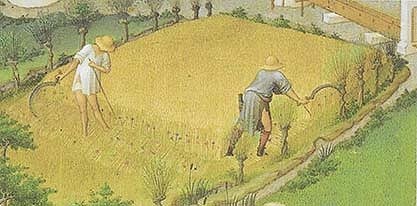
Steyning Museum archives: A Medieval Farming Community
Readers of these articles will already have encountered William de Saon and the Manor of Steyning which, in 1338, recorded all its income and expenditure in meticulous detail, on two long parchment scrolls.Forty percent of the income of the Manor came from rents from burgage plots in the town and from other bits of land they owned, but the fine and extensive detail in these ‘Account rolls’ is all about the farm – what crops were grown, what animals were raised on the farm and what happened to all their produce during the year. We can also see how people were paid and how much work went into the care of the livestock, the preparation of the soil and the harvesting and the threshing of the grain.
The Manor, itself, appears to have included Cherelton (Charlton), Wappingthorn, Wykham and Ashurst where, for each of these little communities, a ‘tithing man’ was appointed as a spokesman and as a conduit for the orders of the Manor. There is also mention of La Hamer (Ham Farm?) and of Gatewycke. The farm mentioned most frequently, however, is Houdelston (Huddleston). Much of the Manor’s grain and other produce was stored in their barn or granary. Indeed, we know that in 1338 their barn got a new roof, with 7½ d. being spent on candles for its consecration. Other barns and granaries, the principal one being described as the Lord’s barn, played a large part in the farming life of the community – though where they were we don’t know.
The ‘tithing men’ were not the only people ensuring that the manor farm ran smoothly. The ‘bailiff’ or ‘reeve’ for the Manor, a man called Walter Benett, allotted the jobs to be done each day to the day-labourers and skilled men. Another key task was performed by Adam Wakelyn, the ‘hayward’, whose special responsibilities were for the care of hedges and for the sowing of the seed, having first ensured that the ploughing and the harrowing had been done to his satisfaction.
A dozen of those identified by name, who worked for the Manor of Steyning 680 years ago, were identified as being ‘Franklins’. These were Free Men who didn’t owe any customary service to the Lord of the Manor. They probably owned no property but they were wealthy enough to rent and farm more extensive lands than other peasants and accepted responsible roles in the community – for which they were paid. Among them were John le Babbe the ‘constable’, Mathew Goldyng the ‘forester’ and John Wolgar, described as the ‘rider’. He was employed at harvest time to ride round the fields to ensure that all was going well. It was a time of the year when all hands were concentrating on ensuring that no time should be lost in bringing in the harvest in good condition. The well-being of the community depended on it.
The hard graft in the fields was not performed by the Free Men but by lesser peasants, who owed customary service to the Manor, in exchange for their cottages, and by men employed directly as servants of the Manor. Their contribution was measured in terms of ‘day-works’, a ‘day-work’ being the period from dawn till lunchtime – maybe 7 hours in high summer but much less in the winter. Twenty four Steyning men gave ‘day-work’ service to the Manor farm on up to three occasions each week – a total of 2,800 ‘day-works’ in that year.
This all gives some idea of how the Manor of Steyning was managed in 1338 but there is still more to discover, so we may have to return again to these Account Rolls at some future date.

